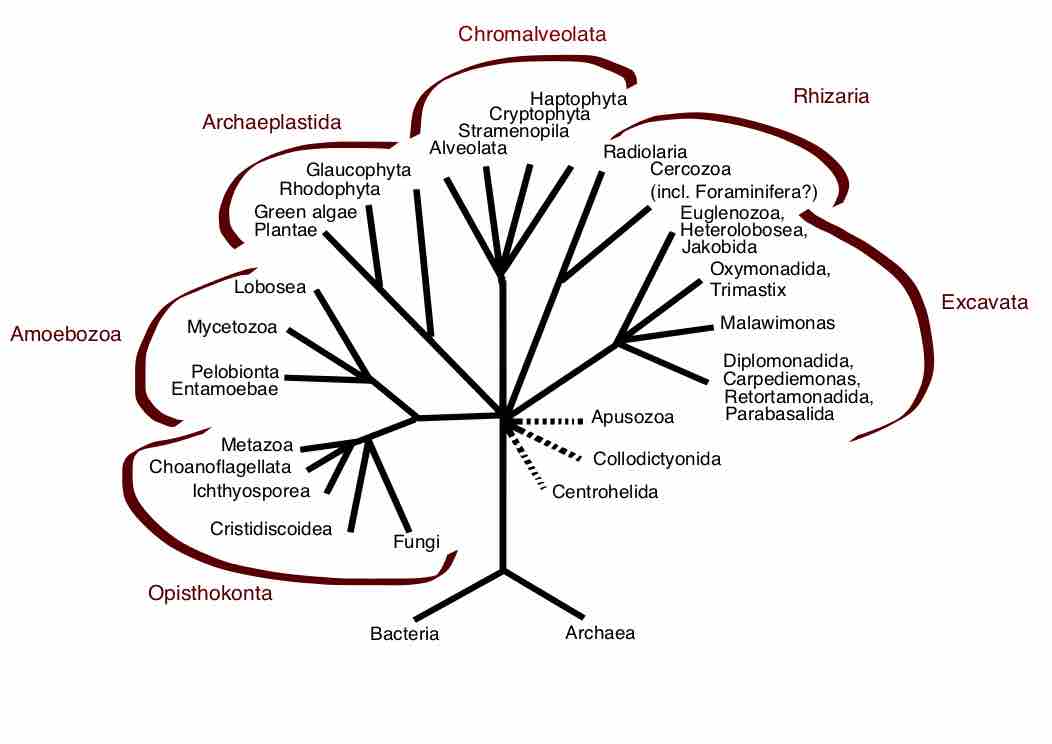Phylogeny of the Eukarya
A eukaryote is an organism whose cells contain complex structures enclosed within membranes. Eukaryotes may more formally be referred to as the taxon Eukarya or Eukaryota. The defining membrane-bound structure that sets eukaryotic cells apart from prokaryotic cells is the nucleus, or nuclear envelope, within which the genetic material is carried. Most eukaryotic cells also contain other membrane-bound organelles such as mitochondria, chloroplasts, and the Golgi apparatus. All large complex organisms are eukaryotes, including animals, plants, and fungi. The group also includes many unicellular organisms.
rRNA trees constructed during the 1980s and 1990s left most eukaryotes in an unresolved crown group, which was usually divided by the form of the mitochondrial cristae. The few groups that lack mitochondria branched separately, and so the absence was believed to be primitive. But this is now considered an artifact of a divergent evolutionary line, and they are known to have lost them secondarily.
Eukaryotes are split into 6, subdivisions, referred to as kingdoms . They include:

The Six Kingdoms
This is one hypothesis of eukaryotic relationships. The Opisthokonta group includes both animals (Metazoa) and fungi. Plants (Plantae) are placed in Archaeplastida.
1. Excavata - Various flagellate protozoa
2. Amoebozoa - Most lobose amoeboids and slime moulds
3. Opisthokonta - Animals, fungi, choanoflagellates
4. RhizariaForaminifera - Radiolaria, and various other amoeboid protozoa
5. ChromalveolataStramenopiles (or Heterokonta) - Haptophyta, Cryptophyta (or cryptomonads), and Alveolata
6. Archaeplastida (or Primoplantae) - Land plants, green algae, red algae, and glaucophytes
There is widespread agreement that the Rhizaria belong with the Stramenopiles and the Alveolata, in a clade dubbed the SAR supergroup, so that Rhizara is not one of the main eukaryote groups. The Amoeboza and Opisthokonta are each monophyletic and form a clade, often called the unikonts. There is debate about the true constituents of the animal kingdoms.
Beyond this, there does not appear to be a consensus. It has been estimated that there may be 75 distinct lineages of eukaryotes. Most of these lineages are protists. The known eukaryote genome sizes vary from 8.2 megabases (Mb) in Babesia bovis to 112,000 to 220,050 Mb in the dinoflagellate Prorocentrum micans. This suggests that the genome of the ancestral eukaryote has undergone considerable variation during its evolution. The last common ancestor of all eukaryotes is believed to have been a phagotrophic protist with a nucleus, at least one centriole and cilium, facultatively aerobic mitochondria, sex (meiosis), a dormant cyst with a cell wall of chitin, cellulose, and peroxisomes. Later endosymbiosis led to the spread of plastids in some lineages.